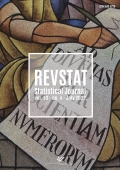Smooth PLS Regression for Spectral Data
DOI:
https://doi.org/10.57805/revstat.v20i4.383Keywords:
PLS regression, Krylov subspaces, discrete wavelet transform, spectroscopyAbstract
Partial least squares (PLS) regression reduces the regression problem from a large-p number of interrelated predictors to a small-m number of extracted factors. These use information for predicting the response making PLS regression models extremely good for prediction purposes. The PLS regression coefficient vector is determined by the PLS factor loadings which drive the dimension reduction process; it should therefore be smooth, especially when the factor subspace dimension is small. We explore smooth alternatives for PLS regression revisiting a topic that triggered the research interest over the last two decades. We use for this the discrete wavelet transform focusing on PLS regression applications in near infra-red spectroscopy.
Downloads
Published
How to Cite
Issue
Section
License
Copyright (c) 2020 REVSTAT-Statistical Journal

This work is licensed under a Creative Commons Attribution 4.0 International License.

